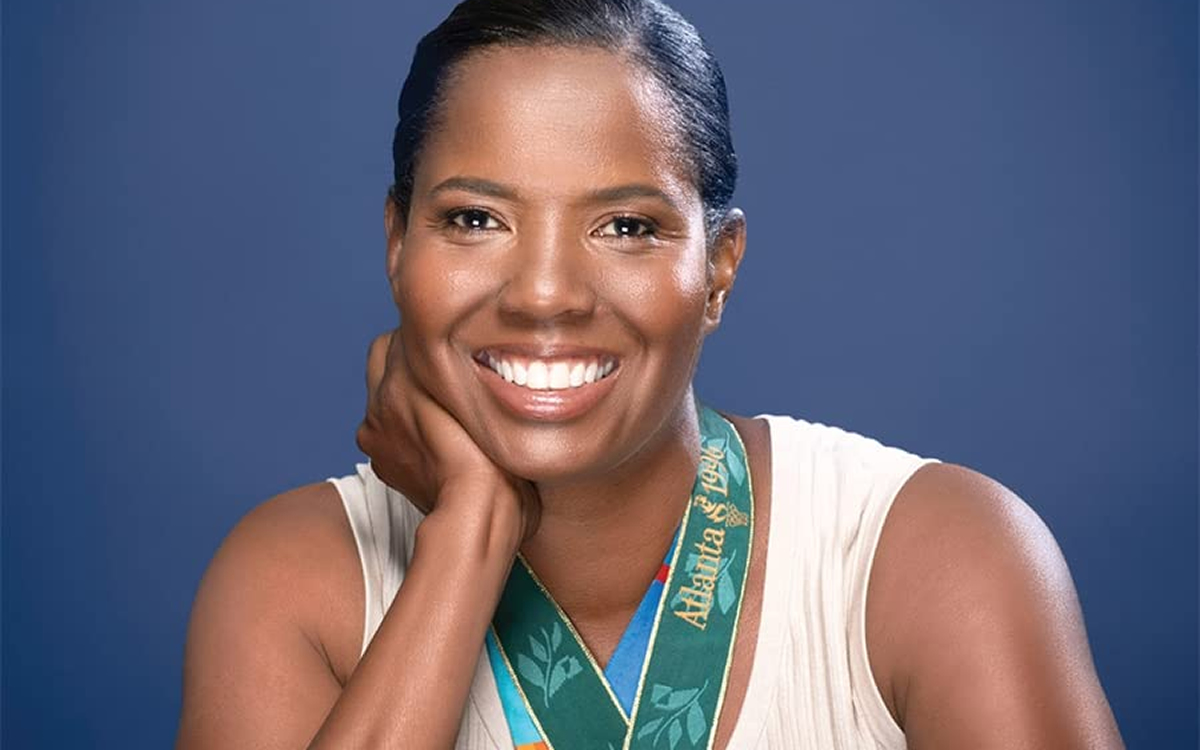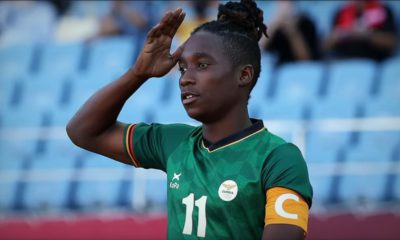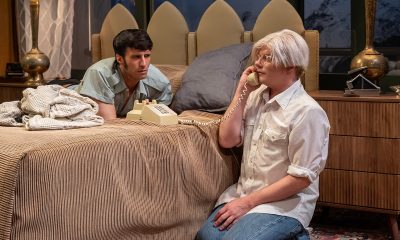Books
Trailblazing soccer legend Briana Scurry inspires with new book
‘My Greatest Save’ recounts highs and lows of her remarkable life

Black lesbian soccer icon Briana Scurry knew from the get-go that she would compete in the Olympics.
In February 1980, Scurry, then eight, was in the family room in her home in Dayton, Minn., watching the Winter Olympics, held that year in Lake Placid, N.Y. The United States was playing hockey against Russia. In what became known as “the Miracle on Ice,” the U.S. Olympic team won the gold medal.
Scurry cheered for the U.S. team. But Jim Craig, the team’s goaltender, especially, became a hero for her. “One day I am going to be an Olympian, too,” Scurry decided.
This sounds like a child’s daydream – with as much chance of becoming a reality as a happily-ever-after-Disney movie.
But trailblazing soccer legend Briana Scurry has proved that, with talent, hard work, support from family and friends, along with a sense of humor, dreams can come true.
The child who dreamed of being an Olympian grew up to find herself on the Wheaties box for her winning save as goalkeeper for the U.S. Women’s National Soccer Team in the 1999 FIFA World Cup championship game. (FIFA is world soccer’s governing body.)
“I believe I’m the only Black lesbian to be on a Wheaties box,” Scurry, who won the gold medal in the 1996 and 2004 Summer Olympics, said in a recent interview with the Blade.
Scurry’s life has had Olympian highs and hellish lows.
In 2010, her soccer career ended after she sustained a traumatic brain injury during a game. Scurry ran up against an insurance company that wouldn’t pay for the medical care she needed.
At one of her lowest points, she had to pawn her Olympic gold medals to pay for food.
In “My Greatest Save: The Brave, Barrier-Breaking Journey of a World-Champion Goalkeeper,” her revealing, moving, can’t-put-down book, (written with Wayne Coffey), coming out on June 21, Scurry tells her compelling story.
It is “more than the story of an all-time great goalkeeper,” tennis legend and LGBTQ icon Billie Jean King said of “My Greatest Save.” “It’s about a pioneering female athlete who made sure to honor those who came before her even as she worked hard to make things better for those who came after her.”
“It was time,” Scurry said when asked why she wrote the book, “I was in a good place to do it.”
When you’re in a tough situation it’s hard to see how to write about it, she added, “I had to go away from it to go back to it. We started in 2020 right before the pandemic.”
Scurry hopes the book will inspire readers. “I hope it will encourage people to blaze trails in their own lives,” she said.
Scurry wanted readers to see behind the veil of a professional athlete – to see how she overcame obstacles, kept going, and reached her goals.
Throughout her life and career, Scurry has encountered obstacles and barriers from a traumatic brain injury to racism and homophobia.
From early on, Scurry was aware that she was different. There were few people of color when she was in elementary, middle, or high school. The youth soccer teams that she played on were also predominantly white. During her 17 years with the U.S. Women’s Soccer National Team, “it was the same thing — at least among the core players,” she writes in “My Greatest Save.”
In 2017, Scurry became the first Black woman to be elected to the National Soccer Hall of Fame, and she is one of the first out LGBTQ soccer players.
Scurry was so supportive of other queer soccer players that she became known as the “welcome wagon.”
“When I played with the Atlanta Beat we’d compete fearlessly against the opposing team,” Scurry said. “But after the game, [the Atlanta and the opposing team] wanted to hang out.”
Scurry would take the LGBTQ home and opposing players to a fun, safe place — a bar where they could grab something to eat and dance. “Then we’d go back to competing ferociously in the next game,” she said.
Scurry thinks she has been discriminated against because of how she looks. “Because I’m Black and lesbian,” she said.
In 1999, after the World Cup win, Scurry kissed her then girlfriend. “When we kissed the TV cameras cut away because we were lesbians.”
She also believes that she’s received fewer offers for commercial endorsements than white, heterosexual athletes.
Scurry worries about the “Don’t Say Gay” and anti-trans laws that are being passed nationwide. “I worry that these [queer] kids will be bullied. That they might become suicidal,” she said.
“I wrote my book for LGBTQ kids,” Scurry said, “I want them to believe in themselves and to believe that they can be athletes.”
“We’re going backwards,” Scurry added. “It’s frustrating. It’s tiring but we’re going to have to keep fighting for our rights.”
Scurry was forced to engage in one of the toughest fights of her life after she had a traumatic brain injury while playing soccer in 2010. After she was injured, Scurry was labeled “temporarily totally disabled.” That label was a severe understatement.
Scurry’s head injury left her in unbearable pain. It was incredibly hard for her to concentrate on the simplest things — from reading more than a couple of paragraphs to following the plot of a TV show.
Scurry became so depressed that she came close to ending her life. (If you are having suicidal thoughts, contact the Trevor Project and/or the National Suicide Prevention Lifeline).
“The insurance company said I was faking it,” Scurry said. “I told them I was a professional athlete. There was nothing I wanted more in the world than to get back in the game.”
“Why in the world would I have wanted to fake not being able to work?” she said.
Thankfully, in this low period in her life, Scurry was connected, through friends to Chryssa Zizos, who works in public relations.
Zizos publicized Scurry’s struggle with the insurance company. The publicity was effective. The company agreed to pay for the physical therapy and surgery that Scurry needed.
Today, Scurry and Zizos are happily married. Scurry loves being step-mom to Zizos’s children, who call her “bonus mom.”
Scurry, now fully recovered, talks about her traumatic brain injury to educate soccer players, coaches, and parents about concussions.
“There’s more research now about ways to help protect players from concussions,” she said.
Headbands would help protect players against concussions, Scurry said. “Some of the players won’t wear headbands,” she added, “because it would be perceived as weakness.”
Shin guards used to be voluntary, and players didn’t wear them, Scurry said.
“But after FIFA mandated them, players wore them,” she said. “The same thing would happen if FIFA mandated headbands.”
Scurry was thrilled last month when news broke from The New York Times and other outlets that landmark contracts had been signed with the U.S. Soccer Federation. The contracts say that, for the first time, men and women soccer teams will be paid equally in international matches and competitions. The agreement says that in forthcoming World Cup tournaments men and women will be paid equally in money awarded by FIFA in prizes.
“I’m overjoyed about women getting equal pay,” Scurry said.
Fifty years ago this month, Title IX of the Education Amendments of 1972 became law. The legislation, which prohibits discrimination against women in education, has enabled thousands of women and girls to participate in sports in high schools, colleges and professionally.
“Title IX opened the door for millions of girls around the country to be able to participate in sports,” Scurry said.
“Without Title IX … there would have been no path for me to play soccer collegiately and professionally,” she added.
The Blade may receive commissions from qualifying purchases made via this post.
Books
Two new books on dining out LGBTQ-style
Visit nightclubs, hamburger joints, and a bathhouse that feeds customers

‘What is Queer Food? How We Served a Revolution’
By John Birdsall
c.2025, W.W. Norton
$29.99/304 pages
‘Dining Out: First Dates, Defiant Nights, and Last Call Disco Fries at America’s Gay Restaurants’
By Erik Piepenburg
c.2025, Grand Central
$30/352 pages
You thought a long time about who sits where.
Compatibility is key for a good dinner party, so place cards were the first consideration; you have at least one left-hander on your guest list, and you figured his comfort into your seating chart. You want the conversation to flow, which is music to your ears. And you did a good job but, as you’ll see with these two great books on dining LGBTQ-style, it’s sometimes not who sits where, but whose recipes were used.
When you first pick up “What is Queer Food?” by John Birdsall, you might miss the subtitle: “How We Served a Revolution.” It’s that second part that’s important.

Starting with a basic gay and lesbian history of America, Birdsall shows how influential and (in)famous 20th century queer folk set aside the cruelty and discrimination they received, in order to live their lives. They couldn’t speak about those things, he says, but they “sat down together” and they ate.
That suggested “a queer common purpose,” says Birdsall. “This is how who we are, dahling, This is how we feed our own. This is how we stay alive.”
Readers who love to cook, bake or entertain, collect cookbooks, or use a fork will want this book. Its stories are nicely served, they’re addicting, and they may send you in search of cookbooks you didn’t know existed.
Sometimes, though, you don’t want to be stuck in the kitchen, you want someone else to bring the grub. “Dining Out” by Erik Piepenburg is an often-nostalgic, lively look at LGBTQ-friendly places to grab a meal – both now and in the past.

In his introduction, Piepenburg admits that he’s a journalist, “not a historian or an academic,” which colors this book, but not negatively. Indeed, his journeys to “gay restaurants” – even his generous and wide-ranging definitions of the term – happily influence how he presents his narrative about eateries and other establishments that have fed protesters, nourished budding romances, and offered audacious inclusion.
Here, there are modern tales of drag lunches and lesbian-friendly automats that offered “cheap food” nearly a century ago. You’ll visit nightclubs, hamburger joints, and a bathhouse that feeds customers on holidays. Stepping back, you’ll read about AIDS activism at gay-friendly establishments, and mostly gay neighborhood watering holes. Go underground at a basement bar; keep tripping and meet proprietors, managers, customers and performers. Then take a peek into the future, as Piepenburg sees it.
The locales profiled in “Dining Out” may surprise you because of where they can be found; some of the hot-spots practically beg for a road trip.
After reading this book, you’ll feel welcome at any of them.
If these books don’t shed enough light on queer food, then head to your favorite bookstore or library and ask for help finding more. The booksellers and librarians there will put cookbooks and history books directly in your hands, and they’ll help you find more on the history and culture of the food you eat. Grab them and you’ll agree, they’re pretty tasty reads.
The Blade may receive commissions from qualifying purchases made via this post.

You’re going to be on your feet a lot this month.
Marching in parades, dancing in the streets, standing up for people in your community. But you’re also likely to have some time to rest and reflect – and with these great new books, to read.
First, dip into a biography with “Marsha: The Joy and Defiance of Marsha P. Johnson” by Tourmaline (Tiny Rep Books, $30), a nice look at an icon who, rumor has it, threw the brick that started a revolution. It’s a lively tale about Marsha P. Johnson, her life, her activism before Stonewall and afterward. Reading this interesting and highly researched history is a great way to spend some time during Pride month.
For the reader who can’t live without music, try “The Dad Rock That Made Me a Woman” by Niko Stratis (University of Texas Press, $27.95), the story of being trans, searching for your place in the world, and finding it in a certain comfortable genre of music. Also look for “The Lonely Veteran’s Guide to Companionship” by Bronson Lemer (University of Wisconsin Press, $19.95), a collection of essays that make up a memoir of this and that, of being queer, basic training, teaching overseas, influential books, and life.
If you still have room for one more memoir, try “Walk Like a Girl” by Prabal Gurung (Viking, $32.00). It’s the story of one queer boy’s childhood in India and Nepal, and the intolerance he experienced as a child, which caused him to dream of New York and the life he imagined there. As you can imagine, dreams and reality collided but nonetheless, Gurung stayed, persevered, and eventually became an award-winning fashion designer, highly sought by fashion icons and lovers of haute couture. This is an inspiring tale that you shouldn’t miss.
No Pride celebration is complete without a history book or two.
In “Trans History: From Ancient Times to the Present Day” by Alex L. Combs & Andrew Eakett ($24.99, Candlewick Press), you’ll see that being trans is something that’s as old as humanity. One nice part about this book: it’s in graphic novel form, so it’s lighter to read but still informative. Lastly, try “So Many Stars: An Oral History of Trans, Nonbinary, Genderqueer, and Two-Spirit People of Color” by Caro De Robertis (Algonquin Books of Chapel Hill. $32.00) a collection of thoughts, observations, and truths from over a dozen people who share their stories. As an “oral history,” you’ll be glad to know that each page is full of mini-segments you can dip into anywhere, read from cover to cover, double-back and read again. It’s that kind of book.
And if these six books aren’t enough, if they don’t quite fit what you crave now, be sure to ask your favorite bookseller or librarian for help. There are literally tens of thousands of books that are perfect for Pride month and beyond. They’ll be able to determine what you’re looking for, and they’ll put it directly in your hands. So stand up. March. And then sit and read.
a&e features
James Baldwin bio shows how much of his life is revealed in his work
‘A Love Story’ is first major book on acclaimed author’s life in 30 years

‘Baldwin: A Love Story’
By Nicholas Boggs
c.2025, FSG
$35/704 pages
“Baldwin: A Love Story” is a sympathetic biography, the first major one in 30 years, of acclaimed Black gay writer James Baldwin. Drawing on Baldwin’s fiction, essays, and letters, Nicolas Boggs, a white writer who rediscovered and co-edited a new edition of a long-lost Baldwin book, explores Baldwin’s life and work through focusing on his lovers, mentors, and inspirations.
The book begins with a quick look at Baldwin’s childhood in Harlem, and his difficult relationship with his religious, angry stepfather. Baldwin’s experience with Orilla Miller, a white teacher who encouraged the boy’s writing and took him to plays and movies, even against his father’s wishes, helped shape his life and tempered his feelings toward white people. When Baldwin later joined a church and became a child preacher, though, he felt conflicted between academic success and religious demands, even denouncing Miller at one point. In a fascinating late essay, Baldwin also described his teenage sexual relationship with a mobster, who showed him off in public.
Baldwin’s romantic life was complicated, as he preferred men who were not outwardly gay. Indeed, many would marry women and have children while also involved with Baldwin. Still, they would often remain friends and enabled Baldwin’s work. Lucien Happersberger, who met Baldwin while both were living in Paris, sent him to a Swiss village, where he wrote his first novel, “Go Tell It on the Mountain,” as well as an essay, “Stranger in the Village,” about the oddness of being the first Black person many villagers had ever seen. Baldwin met Turkish actor Engin Cezzar in New York at the Actors’ Studio; Baldwin later spent time in Istanbul with Cezzar and his wife, finishing “Another Country” and directing a controversial play about Turkish prisoners that depicted sexuality and gender.
Baldwin collaborated with French artist Yoran Cazac on a children’s book, which later vanished. Boggs writes of his excitement about coming across this book while a student at Yale and how he later interviewed Cazac and his wife while also republishing the book. Baldwin also had many tumultuous sexual relationships with young men whom he tried to mentor and shape, most of which led to drama and despair.
The book carefully examines Baldwin’s development as a writer. “Go Tell It on the Mountain” draws heavily on his early life, giving subtle signs of the main character John’s sexuality, while “Giovanni’s Room” bravely and openly shows a homosexual relationship, highly controversial at the time. “If Beale Street Could Talk” features a woman as its main character and narrator, the first time Baldwin wrote fully through a woman’s perspective. His essays feel deeply personal, even if they do not reveal everything; Lucian is the unnamed visiting friend in one who the police briefly detained along with Baldwin. He found New York too distracting to write, spending his time there with friends and family or on business. He was close friends with modernist painter Beauford Delaney, also gay, who helped Baldwin see that a Black man could thrive as an artist. Delaney would later move to France, staying near Baldwin’s home.
An epilogue has Boggs writing about encountering Baldwin’s work as one of the few white students in a majority-Black school. It helpfully reminds us that Baldwin connects to all who feel different, no matter their race, sexuality, gender, or class. A well-written, easy-flowing biography, with many excerpts from Baldwin’s writing, it shows how much of his life is revealed in his work. Let’s hope it encourages reading the work, either again or for the first time.




















